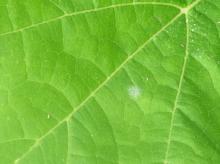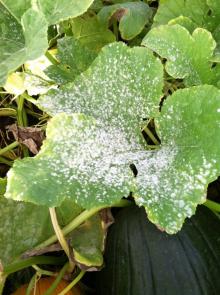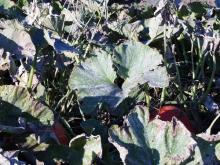Cause The fungi, Golovinomyces cucurbitacearum (formerly G. cichoracearum and Erysiphe cichoracearum), Podosphaera xanthii (formerly P. fuliginea and Sphaerotheca fuliginea), and Leveillula taurica (anamorph = Oidiopsis taurica) can all infect the cucurbits, including squash but G. cucurbitacearum has a lower optimum temperature while P. xanthii appears to more aggressive on cucurbits and causes disease during the warmer summer months. Infection can occur between 50°F and 90°F with 68°F to 81°F being optimum; temperatures above 100°F are reported to halt disease.
Rarely is the sexual stage (chasmothecium) observed in the Pacific Northwest. However, these fungi readily produce conidia, which can be dispersed from infected plants in greenhouses or in the field. Conidia can be moved by wind across long distances. Warm temperatures and dew formation in summer favor disease development; high relative humidity favors infection while drier conditions promote colony growth as well as production and dispersal of conidia. In 3 to 7 days after infection, colonies are visible. Dense plantings and low light conditions promote disease.
Symptoms First, tiny white superficial spots appear on leaves and stem. Spots become powdery white and expand to cover all portions of the plant. Sometimes the mycelium becomes covered with small black structures (chasmothecia) about the size of a pinhead. Usually the disease is in scattered spots in the field but can sometimes be widespread. Severely infected leaves may turn brown, exposing the fruit to sunscald and possibly affecting rind color or storability of winter squash.
Cultural control
- Plant resistant varieties if available (See Varieties Tolerant to Powdery Mildew). Though not immune, these varieties will develop disease more slowly.
- A 2-year rotation out of cucurbits is helpful in case chasmothecia were produced on a previous cucurbit crop.
- Avoid establishment of plants where shaded by tall plants or structures.
- Avoid planting too dense of stands.
Squash (Cucurbita spp.) - Varieties Tolerant to Powdery Mildew
Crop
Cultivar
Pumpkin
Aladdin
Gladiator
Majic Lantern
Merlin
Pure Gold
Winter Squash, Acorn
Royal Ace
Table Star
Taybelle
Yellow Summer Squash
Patriot II
Sunglo
Sunray
Zucchini
Payroll
Sebring
From: Babadoost-Cucurbit Diseases at https://web.extension.illinois.edu/mms/downloads/68768.pdf
Chemical control Good leaf coverage is essential for management by fungicide applications; ensure thxat the underside of leaves and the lower canopy are protected.
- Bicarbonates are registered to control powdery mildew. Thorough coverage is essential.
- Bi-Carb at 4 tsp/2 gal water on 7- to 10-day intervals. May be applied up to the day before harvest. H O.
- Carb-O-Nator at 2.5 to 5 lb/100 gal of water on 5- to 14-day intervals, depending on disease pressure. Preharvest interval is zero (0) days for all listed crops. 4-hr reentry. O
- Kaligreen at 2.5 to 3 lb/A on 7- to 10-day intervals. Might be used to supplement a normal program when powdery mildew is first observed. May be applied up to the day before harvest. 4-hr reentry. O
- MilStop SP at 2 to 5 lb/A on 7- to 14-day intervals. 1-hr reentry. O
- Vacres at 2.5 to 5 lb/A on 7- to 14-day intervals. Preharvest interval is zero (0) days. 4-hr reentry.
- Chlorothalonil formulations (Group M5) are labeled.
- Bonide Fung-onil is available for home gardens. H
- Echo 720 at 2 to 3 pints/A on 7-day intervals. Preharvest interval is 0 days. 12-hr reentry.
- Copper products (Group M1) are not recommended as stand-alone materials.
- Badge SC at 0.5 to 2.5 pints/A on 5- to 7-day intervals. Preharvest interval is 0 days. 24-hr reentry for greenhouse use; 48-hr reentry for all other applications.
- Bonide Liquid Copper is available for home gardens. H
- Champ WG at 1.5 to 2 lb/A on 5- to 7-day intervals. 48-hr reentry. O
- Cueva at 0.5 to 2 gal/100 gal water on 7- to 10-day intervals. May be applied on the day of harvest. 4-hr reentry. O
- Liqui-Cop at 2 to 3 teaspoons/gal water. H
- Nu-Cop 50 DF at 1.5 to 2 lb/A on 5- to 10-day intervals. 48-hr reentry. O
- Previsto at 0.75 to 2 quarts/A on 5- to 7-day intervals. 48-hr reentry. O
- Demethylation-inhibiting (DMI) fungicides (Group 3) are registered for use. Alternate or tank-mix with a non-Group 3 fungicide for resistance management.
- Mettle 125 ME at 8 fl oz/A on 7- to 10-day intervals. Application can be made the day of harvest. 12-hr reentry.
- Rhyme at 5 to 7 fl oz/A on 7- to 14-day intervals. Preharvest interval is 0 days. 12-hr reentry.
- Tebuzol 3.6F at 4 to 6 fl oz/A on 7- to 14-day intervals. Do not apply within 7 days of harvest. 12-hr reentry.
- Topguard at 10 to 14 fl oz/A on 7-day intervals. Preharvest interval is 0 days. 12-hr reentry.
- Fontelis (Group 7) at 12 to 16 fl oz/A on 7- to 14-day intervals. Do not make more than two (2) sequential applications before alternating to a labeled fungicide with a different mode of action (non-Group 7). Preharvest interval is 1 day. 12-hr reentry.
- Oils are labeled to control powdery mildew. Cannot be used with or close to sulfur applications. Do not spray if temperature is below 50°F or above 90°F or when plants are wet or under heat or moisture stress. See label for details. Do not use when foliage is wet as good coverage is essential. Poor control as a stand-alone product.
- JMS Stylet Oil at 3 to 6 quarts/100 gal water. 4-hr reentry. O
- Neem oil 70% at 0.5% to 1% or Neem Oil RTU on 7- to 14-day intervals. H O
- Trilogy at 0.5% to 1%. Not labeled for use in Oregon. 4-hr reentry. O
- OSO 5% SC (Group 19) at 3.75 to 13 fl oz/A on 7- to 14-day intervals. Can be applied the day of harvest. 4-hr reentry. O
- Quintec (Group 13) at 4 to 6 fl oz/A on 10- to 14-day intervals. Do not make more than two (2) consecutive applications before alternating to a fungicide with a different mode of action. Do not apply within 3 days of harvest. 12-hr reentry.
- Regalia (Group P5) at 1 to 4 quarts/A plus another fungicide on 7- to 10-day intervals. Does not benefit from the addition of an adjuvant. Preharvest interval is 0 days. 4-hr reentry. O
- Strobilurin fungicides (Group 11) are labeled for use. Do not make more than one (1) application of a Group 11 fungicide before alternating to a labeled fungicide with a different mode of action.
- Cabrio EG at 12 to 16 oz/A. Preharvest interval is 0 days. 12-hr reentry.
- Evito 480 SC at 3.0 to 5.7 fl oz/A. Preharvest interval is 1 day. 12-hr reentry.
- Flint Extra at 2 to 3.8 fl oz/A. Preharvest interval is 7 days.12-hr reentry.
- Quadris Flowable at 11.0 to 15.4 fl oz/A. Preharvest interval is 1 day. 4-hr reentry.
- Torino (Group U6) at 3.4 fl oz/A on no shorter than 7-day intervals. Preharvest interval is 0 days; can be applied the day of harvest. 4-hr reentry.
Note: Premixes of fungicides are available and offer ease for fungicide resistance management. Do not make more than one (1) application of a Group 11 fungicide before alternating to a labeled fungicide with a different mode of action; for other fungicide groups apply no more than two (2) sequential applications alternating with another fungicide with a different mode of action.
- Affiance (Group 3 + 11) at 12 fl oz/A on 7- to 10-day intervals. Preharvest interval is 1 day. 12-hr reentry.
- Aprovia Top (Group 7 + 3) at 10.5 to 13.5 fl oz/A on 7- to 14-day intervals. May be applied the day of harvest. 12-hr reentry.
- Dexter Xcel (Group M3 + 11 + 3) at 64 fl oz/A on 7- to 10-day intervals. Preharvest interval is 7 days. 24-hr reentry.
- Inspire Super (Group 3 + 9) is registered for powdery mildew of cucumber but is not recommended due the fact that the Group 9 chemistry that is only suppressive to powdery mildew at best. 12-hr reentry.
- ManKocide (Group M1 + M3) at 2 to 3 lb/A on 7- to 10- day intervals. Under moderate to severe disease pressure use the higher rate on 5- to 7-day intervals. Do not apply within 5 days of harvest. 48-hr reentry.
- Merivon Xemium (Group 7 + 11) at 4 to 5.5 fl oz/A on 7- to 14-day intervals. Preharvest interval is 0 days. 12-hr reentry.
- Miravis Prime (Group 7 + 12) at 9.2 to 11.4 fl oz/A on 7- to 14- day intervals. Preharvest interval is 1 day. 12-hr reentry.
- Orondis Opti (Group M5 + 49) at 1.75 to 2.5 pints/A on 7- to 14-day intervals. May be applied the day of harvest. 12-hr reentry.
- Pristine (Group 7 + 11) at 12.5 to 18.5 oz/A. Preharvest interval is 0 days. 12-hr reentry.
- Quadris Opti (Group 11 + M5) at 3.2 pints/A or Quadris Top (Group 11 + 3) at 12 to 14 fl oz/A. Preharvest interval is 1 day. 12-hr reentry.
- Switch 62.5WG (Group 12 + 9) at 11 to 14 oz/A on 7-day intervals. Do not apply within 1 day of harvest. 12-hr reentry.
Biological control
- Actinovate AG at 3 to 12 oz/A as a foliar spray on 7- to 14-day intervals. 4-hr reentry. O
- Actinovate Lawn & Garden at 0.5 to 1 teaspoon/gal water. H O
- Double Nickel LC at 1 to 6 quarts/A on 3- to 10-day intervals. Can be applied the day of harvest. 4-hr reentry. O
- Ecoswing at 1.5 to 2 pints/A. Preharvest interval is 0 days. 4-hr reentry. O
- LifeGard WG at 1 to 4.5 oz/A on 7- to 14-day intervals for activating plant resistance. Refer to label for appropriate rate per application volume. Preharvest interval is 0 days. 4-hr reentry. O
- Romeo at 0.45 lb/A on 7- to 10-day intervals starting prior to infection. Preharvest interval is 0 days. 4-hr reentry. O
- Serenade Opti (Group BM02) at 14 to 20 oz/A on 7- to 10-day intervals. Applications can be made up to and the day of harvest. 4-hr reentry. O




